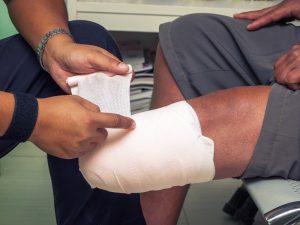[vc_row][vc_column][vc_column_text] According to The Centers for Disease Control, there are nearly two million amputees in the US, with more than 500 amputations performed each day. However, despite its prevalence, the amputation recovery process can evoke feelings of isolation. And an amputee may endure both physical and emotional anguish as they strive for normalcy in the aftermath of their surgery. In this article, we will examine life after the loss of one’s limb and the mental and physical healing it requires.[/vc_column_text][vc_empty_space][vc_column_text]
According to The Centers for Disease Control, there are nearly two million amputees in the US, with more than 500 amputations performed each day. However, despite its prevalence, the amputation recovery process can evoke feelings of isolation. And an amputee may endure both physical and emotional anguish as they strive for normalcy in the aftermath of their surgery. In this article, we will examine life after the loss of one’s limb and the mental and physical healing it requires.[/vc_column_text][vc_empty_space][vc_column_text]
Common causes for limb loss:
[/vc_column_text][vc_column_text]Congenital disabilities, traumatic injuries, and even disease can cause an individual to lose a limb. However, the majority of amputations are related to complications from diabetes and vascular diseases. Other frequent victims of limb loss include those involved in military combat, or a car, motorcycle, or boating accident. However, this is highly dependant on a person’s age. Accidents are more likely to affect the age group between 15 and 35, while disease-caused amputations are more common in those aged 65 to 80.[/vc_column_text][vc_empty_space][vc_column_text]
Amputation:
[/vc_column_text][vc_column_text]In an amputation surgery, a skilled surgeon will determine where they can cut while saving as much of the patient’s limb as possible to salvage any function. The remaining nerves and blood vessels will be sealed off as the surrounding muscles are shaped for the anticipated prosthetic. Despite the invasiveness and intensity of the surgery, it is a small part of the patient’s amputation experience. That’s because the physical therapy and recovery process that is to come is particularly extensive and often painful.[/vc_column_text][vc_empty_space][vc_column_text]
Phantom Pains:
[/vc_column_text][vc_column_text]Most amputee patients experience what is referred to as “phantom pains.” These physical sensations stem from the removed limb and can present shooting pain, burning, and itching. While they are experienced differently in every patient, most will have phantom pains to some degree and over a specified period. Typically, they will last for months to years, although some patients will report such pains for the remainder of their lifetime.[/vc_column_text][vc_empty_space][vc_column_text]
Recovery:
[/vc_column_text][vc_column_text]After surgery, an amputee patient faces their greatest challenge. The recovery process that follows one’s loss of a limb is arduous and exceptionally painful. Yet, with prolonged support and a positive mindset, many endure and can function with significant independence and freedom. Physical therapy involves learning how to use a prosthetic, which gives individuals newfound mobility, often allowing them to resume their favorite activities.[/vc_column_text][vc_empty_space][vc_column_text]It is essential to also take note of the emotional toll of the post-surgery recovery process. Depression is a common experience among amputee patients and should be treated with serious concern. Patients often question their self worth as their image, lifestyle, career, and independence are hindered. In anticipation of this emotional devastation, victims of limb loss should not hesitate to seek counsel or mental health treatment of some sort.[/vc_column_text][vc_empty_space][vc_column_text]If you or a loved one has suffered from the loss of a limb by the fault of another party, make sure that you seek legal counsel as well. In this challenging time, you must receive legal advisement so that you might be justly compensated for your suffering. We at Raynes | Erickson specialize in catastrophic injury law and are here for your guidance and advocacy. Call on us today.[/vc_column_text][/vc_column][/vc_row]
